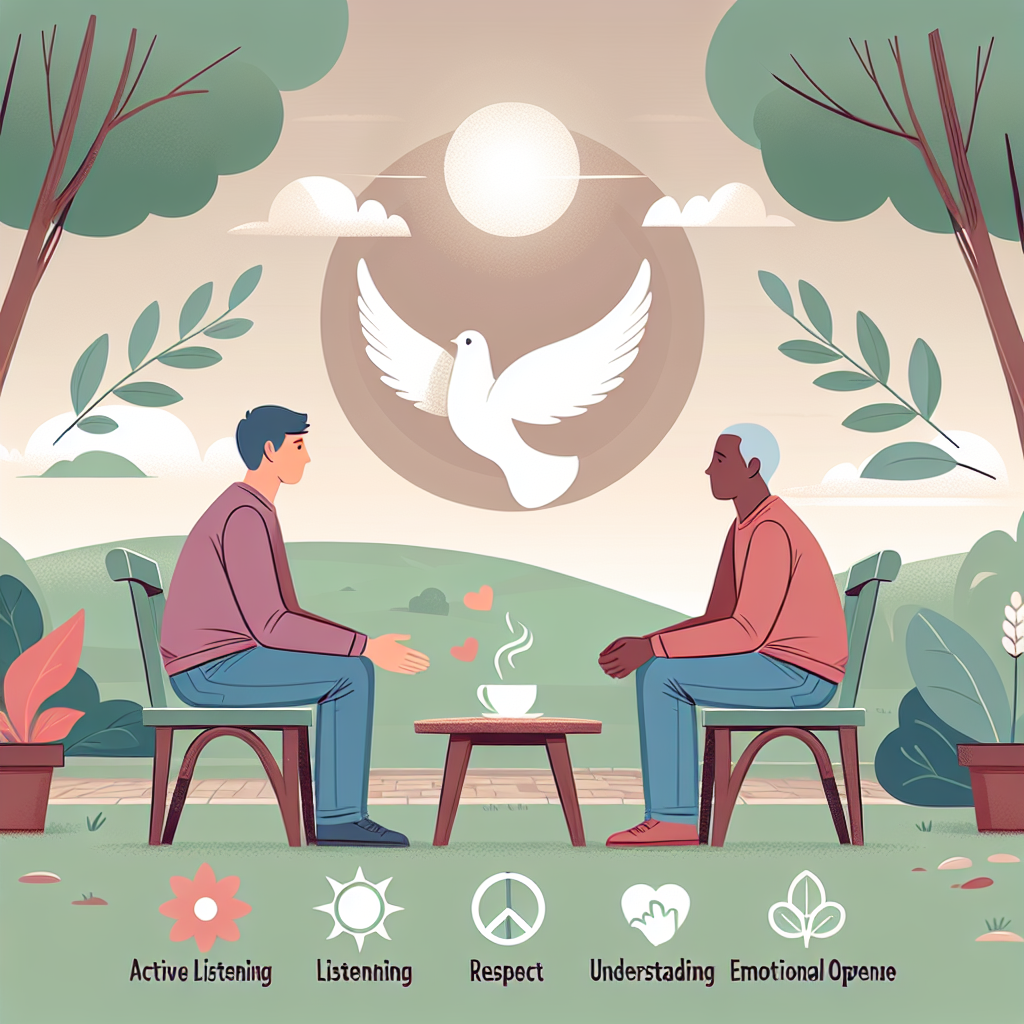How to Practice Non-Violent Communication for Healthier Relationships

Start improving your relationships today by learning how to practice non-violent communication. Visit My Vibrant Vitality now to begin your journey towards healthier, more fulfilling connections.
Mastering the Art of Non-Violent Communication for Stronger Relationships
Non-violent communication (NVC) is a powerful tool that can significantly improve the quality of your relationships. It is a method of communication that encourages empathy, understanding, and compassion, and it can be used in a variety of contexts, from personal relationships to professional interactions. By mastering the art of non-violent communication, you can foster healthier, stronger relationships that are built on mutual respect and understanding.
Non-violent communication is based on the idea that all human beings have the capacity for compassion and empathy. It suggests that violent behavior, whether physical or verbal, is a learned response that stems from the inability to express our needs in a healthier, more productive way. NVC provides a framework for expressing these needs in a way that promotes understanding and connection, rather than conflict and disconnection.
The first step in practicing non-violent communication is to observe without judgment. This means noticing what is happening around you without attaching any labels or evaluations to it. For example, instead of saying “You’re always late,” you might say, “I noticed that you arrived after the agreed time.” This approach removes blame and criticism, making it easier for the other person to hear what you’re saying without becoming defensive.
The next step is to express your feelings. Instead of blaming the other person for how you feel, take ownership of your emotions. You might say, “I feel frustrated when you arrive late,” instead of “You make me so frustrated when you’re late.” This shift in language acknowledges that your feelings are your own, and not directly caused by someone else’s actions.
After expressing your feelings, it’s important to communicate your needs. This is where you explain why you feel the way you do. For example, you might say, “I feel frustrated when you arrive late because I need to feel that our time is respected.” By expressing your needs, you give the other person a clear understanding of what you’re asking for.
The final step in non-violent communication is to make a request. This is where you ask the other person to take a specific action that would meet your needs. For example, you might say, “Would you be willing to make an effort to arrive on time in the future?” By making a clear, specific request, you give the other person the opportunity to respond in a way that meets your needs.
Practicing non-violent communication requires patience and practice. It may feel awkward or unnatural at first, but with time, it can become a natural part of your communication style. Remember, the goal of NVC is not to get your own way, but to create a connection that allows everyone’s needs to be met.
In conclusion, non-violent communication is a powerful tool for improving your relationships. By observing without judgment, expressing your feelings, communicating your needs, and making clear requests, you can foster a deeper understanding and connection with others. So, why not give it a try? You might be surprised at the positive impact it can have on your relationships.
Implementing Non-Violent Communication Techniques for Healthier Interactions

Non-violent communication (NVC) is a powerful tool that can significantly improve the quality of our relationships. It is a method of communication that encourages empathy, understanding, and compassion, fostering healthier interactions between individuals. Implementing non-violent communication techniques can be transformative, leading to more meaningful and fulfilling relationships.
The first step in practicing non-violent communication is to cultivate self-awareness. This involves recognizing and understanding our own feelings and needs. Often, we react impulsively to situations, driven by our emotions, without taking the time to understand what we are truly feeling or why. By becoming more self-aware, we can identify our feelings and needs, and express them in a non-violent manner. This not only helps us to communicate more effectively, but also promotes emotional intelligence, which is crucial for healthy relationships.
Next, it is important to develop empathy for others. Empathy is the ability to understand and share the feelings of another person. It involves putting ourselves in their shoes and seeing things from their perspective. This can be challenging, especially when we are in conflict with the other person. However, by practicing empathy, we can gain a deeper understanding of their feelings and needs, which can help to resolve conflicts in a non-violent manner.
In addition to self-awareness and empathy, non-violent communication also involves expressing ourselves honestly and openly. This means sharing our feelings and needs without blaming or criticizing the other person. It involves using “I” statements, such as “I feel upset when you don’t listen to me,” rather than “You never listen to me.” This approach helps to prevent defensiveness and promotes open and constructive dialogue.
Furthermore, non-violent communication encourages active listening. This means not only hearing the words that the other person is saying, but also understanding the feelings and needs behind those words. Active listening involves giving the other person our full attention, reflecting back what we have heard, and asking clarifying questions. This shows the other person that we value their perspective and are genuinely interested in understanding their feelings and needs.
Finally, non-violent communication involves making requests rather than demands. This means asking for what we need in a respectful and considerate manner, rather than insisting or demanding. It involves using phrases such as “Would you be willing to…?” rather than “You should…” or “You must…” This approach respects the other person’s autonomy and promotes cooperation rather than coercion.
In conclusion, practicing non-violent communication can significantly improve the quality of our relationships. It involves cultivating self-awareness, developing empathy, expressing ourselves honestly and openly, practicing active listening, and making requests rather than demands. By implementing these techniques, we can foster healthier interactions and build more meaningful and fulfilling relationships. However, like any skill, non-violent communication requires practice. It may feel awkward or unnatural at first, but with time and practice, it can become a natural and integral part of our communication style.
The Role of Non-Violent Communication in Enhancing Relationship Health
Non-violent communication (NVC) is a powerful tool that can significantly enhance the health of our relationships. It is a communication method that emphasizes empathy, authenticity, and respect, fostering a deeper understanding between individuals. By practicing non-violent communication, we can cultivate healthier, more fulfilling relationships, whether they be personal or professional.
Non-violent communication is rooted in the belief that all human beings have the capacity for compassion and empathy. It suggests that violent behavior, whether verbal or physical, is a learned response that stems from the inability to express our needs in a healthier, more productive manner. NVC provides a framework for expressing these needs without resorting to judgment, criticism, or blame.
The first step in practicing non-violent communication is to observe without judgment. This means noticing what is happening around us without attaching any labels or evaluations to it. For instance, instead of saying “You’re always late,” which is a judgment, we might say, “I’ve noticed that you’ve arrived after the agreed time on several occasions.” This observation is free from judgment and opens the door for a more constructive conversation.
The second step is to express our feelings. In NVC, feelings are distinguished from thoughts. Instead of saying “I feel like you don’t care,” which is a thought, we might say, “I feel upset when you arrive late.” This expression of feeling provides a clear, personal reaction to the observed behavior.
The third step is to identify our needs. Needs are universal and everyone has them. They are the underlying reasons for our feelings. In the previous example, the need might be for respect, consideration, or reliability. By identifying and expressing our needs, we give others the opportunity to understand what is important to us.
The final step is to make a request. This is where we ask the other person to take a specific action that would meet our needs. It’s important to note that in NVC, requests are not demands. They are open to negotiation and the other person has the freedom to say no. For instance, we might say, “Would you be willing to make an effort to arrive on time in the future?”
Practicing non-violent communication can have profound effects on our relationships. It fosters a deeper understanding and connection between individuals, as it encourages us to express our needs and feelings openly and honestly. It also promotes empathy, as it requires us to listen to the needs and feelings of others without judgment.
Moreover, NVC can help to resolve conflicts in a more peaceful and productive manner. Instead of resorting to blame or criticism, it encourages us to focus on our needs and to find mutually satisfying solutions. This can significantly reduce tension and hostility in our relationships, leading to a more harmonious and fulfilling interaction.
In conclusion, non-violent communication is a powerful tool for enhancing the health of our relationships. By practicing NVC, we can cultivate a deeper understanding and connection with others, express our needs and feelings in a healthier manner, and resolve conflicts more peacefully. It is a journey of learning and growth that can significantly improve our interpersonal interactions and overall quality of life.